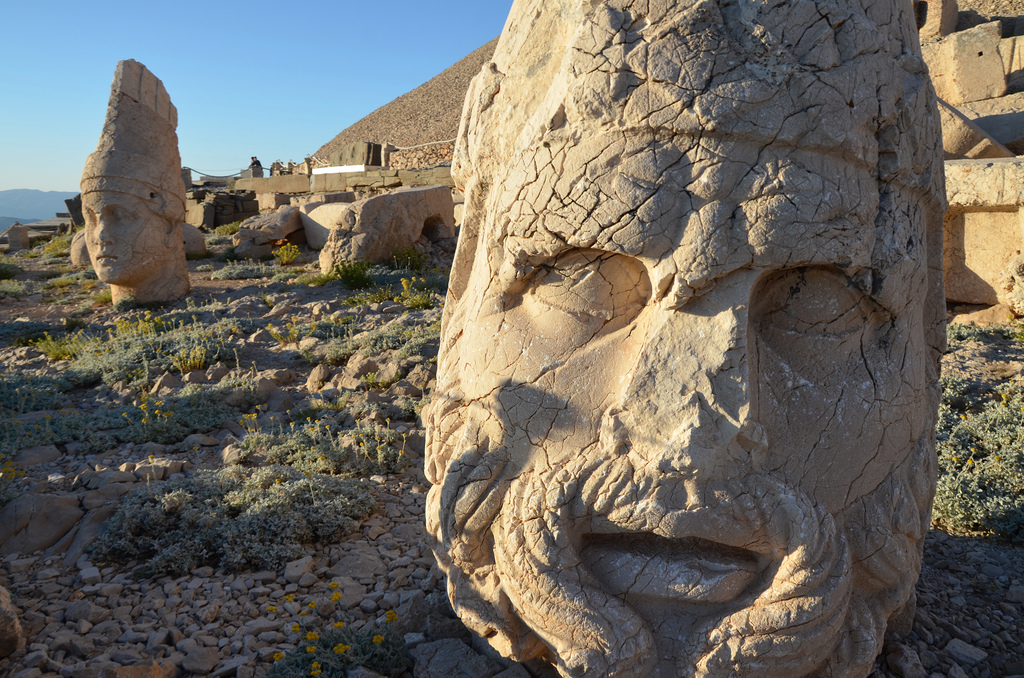Hierotheseion of Antiochus I Mount Nemrut: Unveiling the Majesty of Ancient Commemoration

In the rugged terrain of southeastern Turkey, amidst the majestic peaks of Mount Nemrut, lies a marvel of ancient engineering and artistic expression—the Hierotheseion of Antiochus I. This monumental tomb complex, erected by King Antiochus I of Commagene in the 1st century BCE, stands as a testament to the grandeur and ambition of one of the most enigmatic figures of the Hellenistic period. From its colossal statues and celestial alignments to its intricate reliefs and inscriptions, the Hierotheseion of Antiochus I is a treasure trove of archaeological and cultural significance that continues to captivate scholars and visitors alike.
Historical Context
To understand the significance of the Hierotheseion of Antiochus I, one must delve into the tumultuous history of the ancient Kingdom of Commagene. Situated at the crossroads of major trade routes and cultural influences, Commagene emerged as a powerful and prosperous kingdom in the wake of Alexander the Great’s conquests. Under the reign of Antiochus I, Commagene reached its zenith, with the king consolidating power and asserting Commagene’s independence amidst the shifting tides of regional politics.
In an effort to immortalize his legacy and assert his divine lineage, Antiochus I embarked on a grandiose construction project atop Mount Nemrut, creating a sanctuary that blended elements of Greek, Persian, and Anatolian religious traditions. The result was the Hierotheseion, a monumental complex that served as both a tomb for the king and a place of worship for the deified rulers of Commagene.
Architectural Marvels
The Hierotheseion of Antiochus I is renowned for its architectural ingenuity and artistic sophistication. At the center of the complex stands a massive tumulus, or burial mound, flanked by two terraces adorned with colossal statues of gods, goddesses, and deified ancestors. The most striking feature of the site is the row of seated statues, each over 8 meters in height, representing Antiochus I himself alongside Zeus, Apollo, Hermes, and other divine figures.
The statues are arranged in such a way that they face eastward, towards the rising sun, symbolizing the king’s desire to commune with the gods and ensure his eternal glory. Surrounding the statues are intricately carved reliefs depicting scenes from Greek and Persian mythology, as well as inscriptions in Greek and Aramaic that extol the virtues and accomplishments of Antiochus I.
Astronomical Significance
One of the most intriguing aspects of the Hierotheseion of Antiochus I is its celestial alignment, which is believed to have held profound religious and symbolic significance for the ancient inhabitants of Commagene. Scholars have noted that the orientation of the statues and the layout of the complex correspond to key astronomical events, including the summer and winter solstices, as well as the equinoxes.
This astronomical alignment suggests that the Hierotheseion may have served as an observatory or ritual site for the worship of celestial deities, with rituals and ceremonies conducted in accordance with the movements of the heavens. The complex also includes a series of underground chambers, thought to have been used for religious ceremonies and burial rites, further adding to the mystery and intrigue surrounding the site.
Conservation and Preservation Efforts
In recent years, the Hierotheseion of Antiochus I has faced numerous challenges, including erosion, vandalism, and the impact of tourism. In response, conservation efforts have been undertaken to protect and preserve this invaluable cultural heritage site for future generations. These efforts have included stabilizing the statues and reliefs, implementing visitor management plans, and conducting research to better understand the site’s history and significance.
Additionally, the Hierotheseion of Antiochus I has been nominated for inclusion on the UNESCO World Heritage List, recognizing its outstanding universal value and cultural significance. If successful, this designation would help to ensure the long-term protection and conservation of this remarkable archaeological site, ensuring that it remains accessible to scholars, tourists, and pilgrims for centuries to come.
Conclusion
In conclusion, the Hierotheseion of Antiochus I on Mount Nemrut stands as a testament to the ingenuity, ambition, and religious fervor of the ancient Kingdom of Commagene. Through its monumental architecture, intricate sculptures, and celestial alignments, the site offers a window into the spiritual beliefs and cultural achievements of a bygone era. As efforts continue to preserve and protect this remarkable archaeological treasure, the legacy of Antiochus I and the Kingdom of Commagene will continue to inspire wonder and fascination for generations to come.




